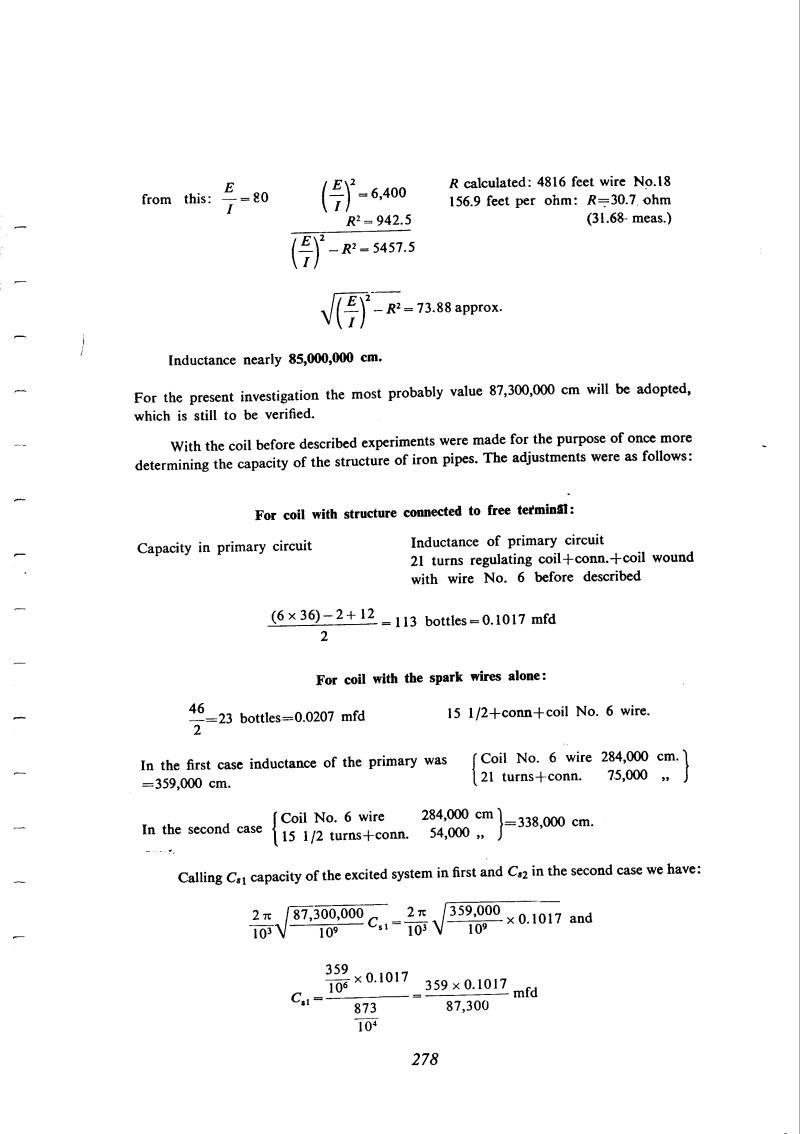
Nikola Tesla Books
| from this: $! {E \over I} $! = 80 | R calculated: 4816 feet wire No. 18 156.9 feet per ohm: R = 30.7 ohm (31.68 meas.) |
| $! {\left({E \over I}\right)^{2}} $! = 6,400 $! {{R^{2} = 942.4} \over {\left({E \over I}\right)^{2} - R^{2} = 5457.5}} $! |
| $! {\sqrt{\left({E \over I}\right)^{2} - R^{2}}} $! = 73.88 approx. |
Inductance nearly 85,000,000 cm.
For the present investigation the most probably value 87,300,000 cm will be adopted, which is still to be verified.
With the coil before described experiments were made for the purpose of once more determining the capacity of the structure of iron pipes. The adjustments were as follows:
For coil with structure connected to free terminal:
| Capacity in primary circuit | Inductance of primary circuit 21 turns regulating coil + conn. + coil wound with wire No. 6 before described |
| $! {{(6 \times 36) - 2 + 12} \over 2} $! = 113 bottles = 0.1017 mfd | |
For coil with the spark wires alone:
| $! {46 \over 2} $! = 23 bottles = 0.0207 mfd | 15 1/2 + conn + coil No. 6 wire. |
| In the first case inductance of the primary was = 359,000 cm. | { | Coil No. 6 wire 284,000 cm. |
| 21 turns + conn. 75,000 " |
| In the second case | { | Coil No. 6 wire | 284,000 cm | } | = 338,000 cm. |
| 15 1/2 turns + conn. | 54,000 " |
Calling Cs1 capacity of the excited system in first and Cs2 in the second case we have:
$! {{2 \pi \over 10^{3}} \sqrt{{87,300,000 \over 10^{9}} {C_{s}}_{1}}} $! = $! {{2 \pi \over 10^{3}} \sqrt{{359,000 \over 10^{9}} \times 0.1017}} $! and
Cs1 = $! {{{359 \over 10^{6}} \times 0.1017} \over {873 \over 10^{4}}} $! = $! {{359 \times 0.1017} \over 87,300} $! mfd
278
November 10
Had Tesla published the measuring methods he developed in New York and Colorado Springs, his name would probably be frequently encountered in earlier textbooks and handbooks on electrical measurements at high frequencies. As it is, we can only remark his exceptional ingenuity in designing measuring devices and the accuracy with which he determined the resonance of oscillatory circuits. An especially interesting feature is his method using a lamp already heated up by a supplementary power source, greatly increasing its sensitivity to small amplitude changes around the resonance peak of the oscillatory circuit.
November 10
He winds a new coil with 1314 turns on the same core on which he wound 689 turns (please see Oct. 18) and later 346 turns (please see Oct. 31). With this coil he measures the metal sphere capacitance again and achieves a similar value as on November 7, with "additional coil". At the end of these measurements and calculations he establishes that the method of resonance determination on the basis of spark length in the arc gap is not quite satisfactory. In the following experiments he changes the resonance determination procedure. He returns to a method which he applied earlier in the New York laboratory. That method was based on the use of an auxiliary secondary coil, in a weak inductive link with excitation system, at which terminal is the instrument for the registration of current or voltage change in the secondary. usually for the registration of changes a small bulb was used. The variation of the method is particularly interesting where the small bulb is preheated by means of a D.C. current (please see Fig. 2). The preheated bulb could register very small excitation changes from the high frequency direct current circuit, which are applied to additionally heat up the already preheated filament in order to emit visual light.
By using the newly applied method of resonance indication he performs some measurements again and he measures the capacitance of a vertical wire 50 ft. in length. After this he switches over to determine the coil self-capacitance with 1314 turns. The measured result he compared with the calculated one for the capacitance of a metal cylinder of the same shape as the coil. According to Tesla, this serves only as a rough estimate. When they are using the entire coil length in the first calculation, he obtained a higher value than measured, he takes the effective coil length on the basis of bare wire. It is obvious that Tesla looks for orientation of the theoretical equations in order to be able to estimate parameters, but the experiment is the most effective factor. As far as the problem of determining the coil self capacitance, this is evident from the first days of the notes (please see eg. June 20, July 3, etc.)

